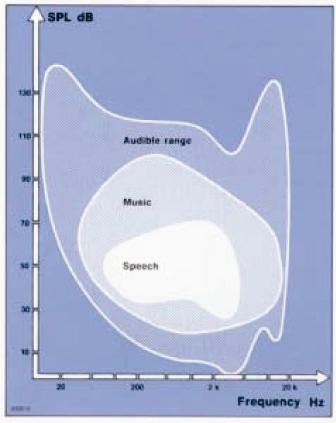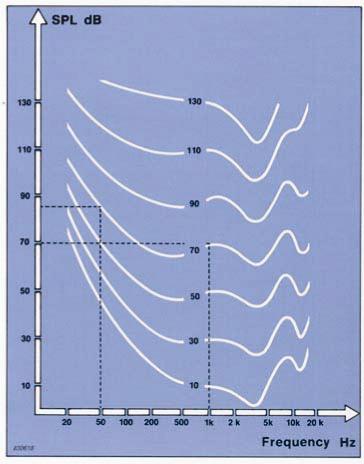|
We have already defined sound as any pressure variation which can be heard by a human ear. This means a range of frequencies from 20 Hz to 20 kHz for a young, healthy human ear. In terms of sound pressure level, audible sounds range from the threshold of hearing at 0 dB to the threshold of pain which can be over 130 dB.
Although an increase of 6 dB represents a doubling of the sound pressure, an increase of about 10 dB is required before the sound subjectively appears to be twice as loud. (The smallest change we can hear is about 3 dB).
The subjective or perceived loudness of a sound is determined by several complex factors. One such factor is that the human ear is not equally sensitive at all frequencies. It is most sensitive to sounds between 2 kHz and 5 kHz, and less sensitive at higher and lower frequencies. |
 |
|
To complicate things even more, this difference in sensitivity
to different frequencies is more pronounced at low SPLs than at high SPLs. This can be seen in the figure which shows a family of equal loudness contours. These indicate the sound pressure level required at any frequency in order to give the same apparent loudness as a 1 kHz tone.
For example, a 50 Hz tone must be 15 dB higher than a 1 kHz tone at a level of 70 dB in order to give the same subjective loudness.
Impulse sounds present another problem in loudness evaluation. If a sound is of short duration, that is, less than one second, it is termed an impulsive or impulse sound. Practical examples of impulse sounds are typewriter and hammering noises. Because of the short duration of such sounds, the ear is less sensitive perceiving it's loudness. Researchers generally agree that the perceived loudness of sounds shorter than 70 milliseconds (70 thousandths of one second) is less than that of sounds of longer durations having the same level. (from Bruel & Kjar) |
 |